This article was co-authored by Miguel Cunha, DPM and by wikiHow staff writer, Eric McClure. Dr. Miguel Cunha is the founder of Gotham Footcare and is a podiatrist based in Manhattan, New York. Dr. Cunha is a foot and ankle surgeon with experience treating a wide array of foot and ankle conditions from minor problems to complex reconstructive foot and ankle surgery. Dr. Cunha received his DPM from the Temple University School of Podiatric Medicine and completed his residency as the Chief Resident at the Washington Hospital Center and Georgetown University where he specialized in lower extremity trauma, diabetic limb salvage, and reconstructive surgery of the foot and ankle. Dr. Cunha is a member of the American Podiatric Medical Association, the New York Podiatric Medical Association, the American College of Foot and Ankle Surgeons, and is board certified in Podiatric Medicine.
There are 11 references cited in this article, which can be found at the bottom of the page.
wikiHow marks an article as reader-approved once it receives enough positive feedback. This article has 13 testimonials from our readers, earning it our reader-approved status.
This article has been viewed 1,482,088 times.
Foot fungus is a general term for any superficial fungal infection on your feet, and in the vast majority of cases, it’s going to be athlete’s foot.[1] While it may be a little uncomfortable, the good news is that getting rid of foot fungus is usually extremely easy, and it’s unlikely that you’ll need to seek out medical help. However, in the event that the fungus doesn’t clear up after 2 weeks of at-home treatment, you’re in serious pain, or the fungus spreads to your nails, see a doctor. They’ll be able to prescribe you something stronger to clear the fungus up.
Steps
How do you get rid of foot fungus at home?
-
1Apply an antifungal topical treatment twice a day for two weeks. There are a ton of foot fungus treatment options, and basically all of them will help clear up your fungus. Talk to a pharmacist or just pick up any OTC antifungal cream, powder, spray, or lotion. Read the label carefully to apply it to your foot. Typically, you just apply the cream, powder, spray, or lotion twice a day until the fungus goes away. According to board-certified podiatrist Miguel Cunha, "A doctor may also prescribe an oral antifungal for more severe cases."
- So long as the ingredients in your product include clotrimazole, econazole, ketoconazole, miconazole, naftifine, oxiconazole, sulconazole, terbinafine, or terconazole, it’s going to help combat the fungus.[2] Ask a pharmacist to help you out if you want to pick the absolute best option based on how your skin is looking, but pretty much any antifungal product will work.
-
2Treat all of your shoes with a disinfectant to kill the fungus inside. Whatever is causing your foot fungus is probably going to be inside of your shoes as well.[3] If you don’t treat your shoes at the same time you’re treating your foot, the fungus may come back. Board-certified podiatrist Miguel Cunha suggests "spraying something like Lysol along the inside and outside of your shoes, which helps kill the bacteria or fungus." Cunha stresses that "both bacteria and fungus can lead to odor, athlete's foot, or fungal nails later on."
- You can do this multiple times if you want to be totally sure that you’ve gotten rid of all of the spores.
Advertisement -
3Keep your feet as dry as possible until the fungus is gone. Fungus likes dark, moist environments, so keeping your feet dry and aired out will help speed the healing process up. Don’t wear shoes unless you absolutely have to, and if you do need to wear shoes, pick a breathable pair. Change your socks out whenever they start to get damp, and never put the same socks on after you’ve taken them off.[4]
Expert Q&A
Did you know you can get expert answers for this article?
Unlock expert answers by supporting wikiHow
-
QuestionWhat can kill a foot fungus?
 Mark Co, DPMDr. Mark Co is a Podiatrist who runs his own private practice in San Francisco, California. Dr. Co specializes in treatments for bunions, ingrown toenails, toenail fungus, warts, plantar fasciitis and other causes of foot pain. He also offers custom orthotics for the treatment and prevention of foot and ankle issues. Dr. Co completed a Master of Business Administration (MBA) at New York University and an MA in Electrical Engineering and Computer Science at Johns Hopkins University. Dr. Co also completed his DPM at the California School of Podiatric Medicine and a residency and internship at the Kaiser Permanente Medical Center, Santa Clara, California. Dr. Co was awarded San Francisco's "Top 3 Podiatrists" in 2018, 2019, and 2020. Dr. Co is also a member of the CPMA (American Podiatric Medical Association).
Mark Co, DPMDr. Mark Co is a Podiatrist who runs his own private practice in San Francisco, California. Dr. Co specializes in treatments for bunions, ingrown toenails, toenail fungus, warts, plantar fasciitis and other causes of foot pain. He also offers custom orthotics for the treatment and prevention of foot and ankle issues. Dr. Co completed a Master of Business Administration (MBA) at New York University and an MA in Electrical Engineering and Computer Science at Johns Hopkins University. Dr. Co also completed his DPM at the California School of Podiatric Medicine and a residency and internship at the Kaiser Permanente Medical Center, Santa Clara, California. Dr. Co was awarded San Francisco's "Top 3 Podiatrists" in 2018, 2019, and 2020. Dr. Co is also a member of the CPMA (American Podiatric Medical Association).
Podiatrist Foot fungus usually results in dry, flaky skin in between the toes, a lot of times on the forefoot, but it can be anywhere on the bottom surface of the foot. It can usually be treated at home with an antifungal cream, although you may need to get a prescription-strength lotion from a doctor if that doesn't work.
Foot fungus usually results in dry, flaky skin in between the toes, a lot of times on the forefoot, but it can be anywhere on the bottom surface of the foot. It can usually be treated at home with an antifungal cream, although you may need to get a prescription-strength lotion from a doctor if that doesn't work. -
QuestionWhat medicines are good for treating severe foot fungus?
 Stephen Chow, MDDr. Chow is an Internal Medicine Physician in Jackson, Mississippi. Dr. Chow received his MD from the Medical University of the Americas 2014 and completed his residency at the University of Mississippi Medical Center. He is a member of the American Board of Internal Medicine.
Stephen Chow, MDDr. Chow is an Internal Medicine Physician in Jackson, Mississippi. Dr. Chow received his MD from the Medical University of the Americas 2014 and completed his residency at the University of Mississippi Medical Center. He is a member of the American Board of Internal Medicine.
Internal Medicine Physician
-
QuestionWhy do people get foot fungus?
 Chris M. Matsko, MDDr. Chris M. Matsko is a retired physician based in Pittsburgh, Pennsylvania. With over 25 years of medical research experience, Dr. Matsko was awarded the Pittsburgh Cornell University Leadership Award for Excellence. He holds a BS in Nutritional Science from Cornell University and an MD from the Temple University School of Medicine in 2007. Dr. Matsko earned a Research Writing Certification from the American Medical Writers Association (AMWA) in 2016 and a Medical Writing & Editing Certification from the University of Chicago in 2017.
Chris M. Matsko, MDDr. Chris M. Matsko is a retired physician based in Pittsburgh, Pennsylvania. With over 25 years of medical research experience, Dr. Matsko was awarded the Pittsburgh Cornell University Leadership Award for Excellence. He holds a BS in Nutritional Science from Cornell University and an MD from the Temple University School of Medicine in 2007. Dr. Matsko earned a Research Writing Certification from the American Medical Writers Association (AMWA) in 2016 and a Medical Writing & Editing Certification from the University of Chicago in 2017.
Family Medicine Physician People get it due to the dampness on the foot from doing exercise or long days on your feet. You might want to try a foot powder to help avoid getting athlete's foot. If you do get athlete's foot, use one of the a over-the-counter anti-fungal treatments. If this does not work seek out the attention of a medical professional.
People get it due to the dampness on the foot from doing exercise or long days on your feet. You might want to try a foot powder to help avoid getting athlete's foot. If you do get athlete's foot, use one of the a over-the-counter anti-fungal treatments. If this does not work seek out the attention of a medical professional.
Warnings
- If you’re diabetic or immunocompromised, any fungal infection should be treated by a doctor. There are several potential complications that you’ll need a doctor to take a look at.[17]⧼thumbs_response⧽
- See a doctor if you’re pregnant or breastfeeding. Certain antifungal medications may not be safe for you, and it’s important to check in with your doctor first.[18]⧼thumbs_response⧽
References
- ↑ https://newsnetwork.mayoclinic.org/discussion/home-remedies-fighting-foot-fungus/
- ↑ https://www.health.harvard.edu/staying-healthy/athletes-foot-causes-prevention-and-treatment
- ↑ https://www.health.harvard.edu/staying-healthy/athletes-foot-causes-prevention-and-treatment
- ↑ https://newsnetwork.mayoclinic.org/discussion/home-remedies-fighting-foot-fungus/
- ↑ https://www.cdc.gov/healthywater/hygiene/disease/athletes_foot.html
- ↑ https://www.nhs.uk/conditions/athletes-foot/
- ↑ https://newsnetwork.mayoclinic.org/discussion/home-remedies-foot-fungal-infections/
- ↑ https://www.mayoclinic.org/diseases-conditions/nail-fungus/diagnosis-treatment/drc-20353300
- ↑ https://www.mayoclinic.org/diseases-conditions/nail-fungus/diagnosis-treatment/drc-20353300
- ↑ https://www.mayoclinic.org/diseases-conditions/athletes-foot/symptoms-causes/syc-20353841
- ↑ https://health.clevelandclinic.org/how-you-can-stop-foot-and-toe-fungus-in-its-tracks/
- ↑ https://www.ncbi.nlm.nih.gov/books/NBK279548/
- ↑ https://www.mayoclinic.org/diseases-conditions/athletes-foot/symptoms-causes/syc-20353841
- ↑ https://www.ncbi.nlm.nih.gov/books/NBK279548/
- ↑ https://www.ncbi.nlm.nih.gov/books/NBK279548/
- ↑ https://patient.info/infections/fungal-infections/antifungal-medicines#nav-1
- ↑ https://health.clevelandclinic.org/how-you-can-stop-foot-and-toe-fungus-in-its-tracks/
- ↑ https://www.nhs.uk/conditions/antifungal-medicines/
About This Article
To get rid of foot fungus like Athlete's Foot, start by applying an over-the-counter antifungal ointment, spray, powder, or cream to the affected area. You can also try taking an over-the-counter medication like butenafine or clotrimazole, but see your doctor for a prescription medication if your case is severe. If you're interested in a homeopathic solution, apply 100% tea tree oil to the affected area 2-3 times per day. To prevent the fungus from returning, wash your feet with antibacterial soap and dry them thoroughly, especially between your toes! To learn about other home remedies you can use to treat foot fungus, read on!
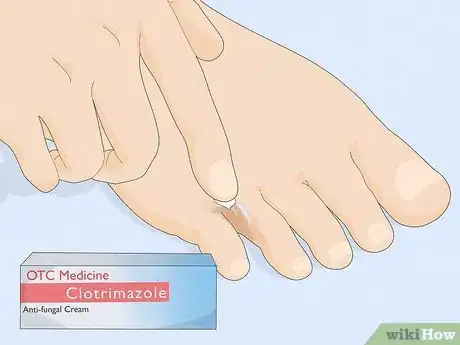




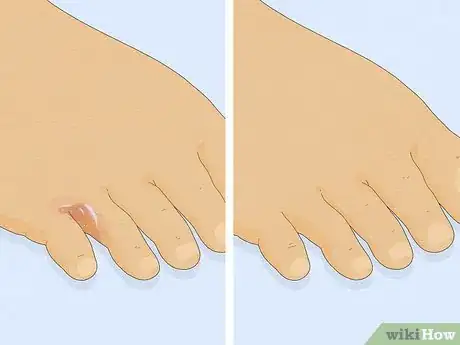
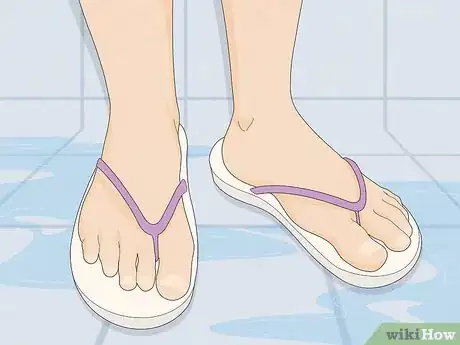




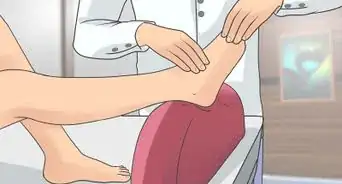
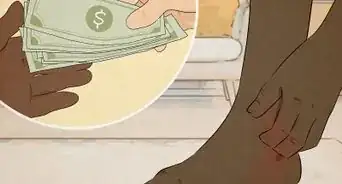

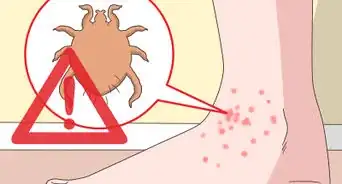



















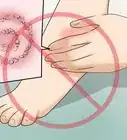

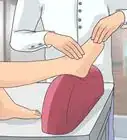



































Medical Disclaimer
The content of this article is not intended to be a substitute for professional medical advice, examination, diagnosis, or treatment. You should always contact your doctor or other qualified healthcare professional before starting, changing, or stopping any kind of health treatment.
Read More...